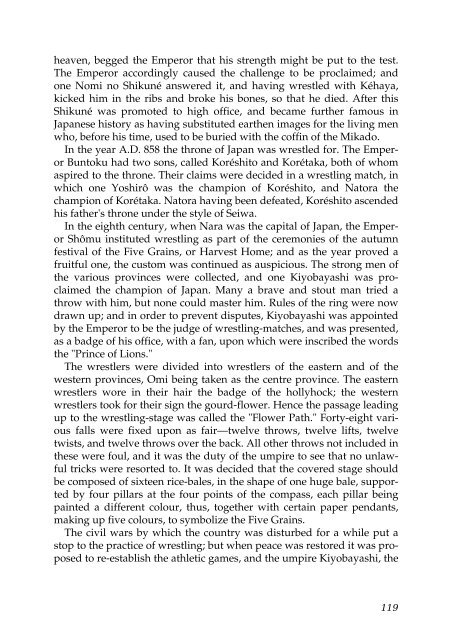Create successful ePaper yourself
Turn your PDF publications into a flip-book with our unique Google optimized e-Paper software.
heaven, begged the Emperor that his strength might be put to the test.<br />
The Emperor accordingly caused the challenge to be proclaimed; and<br />
one Nomi no Shikuné answered it, and having wrestled with Kéhaya,<br />
kicked him in the ribs and broke his bones, so that he died. After this<br />
Shikuné was promoted to high <strong>of</strong>fice, and became further famous in<br />
<strong>Japan</strong>ese history as having substituted earthen images for the living men<br />
who, before his time, used to be buried with the c<strong>of</strong>fin <strong>of</strong> the Mikado.<br />
In the year A.D. 858 the throne <strong>of</strong> <strong>Japan</strong> was wrestled for. The Emperor<br />
Buntoku had two sons, called Koréshito and Korétaka, both <strong>of</strong> whom<br />
aspired to the throne. Their claims were decided in a wrestling match, in<br />
which one Yoshirô was the champion <strong>of</strong> Koréshito, and Natora the<br />
champion <strong>of</strong> Korétaka. Natora having been defeated, Koréshito ascended<br />
his father's throne under the style <strong>of</strong> Seiwa.<br />
In the eighth century, when Nara was the capital <strong>of</strong> <strong>Japan</strong>, the Emperor<br />
Shômu instituted wrestling as part <strong>of</strong> the ceremonies <strong>of</strong> the autumn<br />
festival <strong>of</strong> the Five Grains, or Harvest Home; and as the year proved a<br />
fruitful one, the custom was continued as auspicious. The strong men <strong>of</strong><br />
the various provinces were collected, and one Kiyobayashi was proclaimed<br />
the champion <strong>of</strong> <strong>Japan</strong>. Many a brave and stout man tried a<br />
throw with him, but none could master him. Rules <strong>of</strong> the ring were now<br />
drawn up; and in order to prevent disputes, Kiyobayashi was appointed<br />
by the Emperor to be the judge <strong>of</strong> wrestling-matches, and was presented,<br />
as a badge <strong>of</strong> his <strong>of</strong>fice, with a fan, upon which were inscribed the words<br />
the "Prince <strong>of</strong> Lions."<br />
The wrestlers were divided into wrestlers <strong>of</strong> the eastern and <strong>of</strong> the<br />
western provinces, Omi being taken as the centre province. The eastern<br />
wrestlers wore in their hair the badge <strong>of</strong> the hollyhock; the western<br />
wrestlers took for their sign the gourd-flower. Hence the passage leading<br />
up to the wrestling-stage was called the "Flower Path." Forty-eight various<br />
falls were fixed upon as fair—twelve throws, twelve lifts, twelve<br />
twists, and twelve throws over the back. All other throws not included in<br />
these were foul, and it was the duty <strong>of</strong> the umpire to see that no unlawful<br />
tricks were resorted to. <strong>It</strong> was decided that the covered stage should<br />
be composed <strong>of</strong> sixteen rice-bales, in the shape <strong>of</strong> one huge bale, supported<br />
by four pillars at the four points <strong>of</strong> the compass, each pillar being<br />
painted a different colour, thus, together with certain paper pendants,<br />
making up five colours, to symbolize the Five Grains.<br />
The civil wars by which the country was disturbed for a while put a<br />
stop to the practice <strong>of</strong> wrestling; but when peace was restored it was proposed<br />
to re-establish the athletic games, and the umpire Kiyobayashi, the<br />
119



